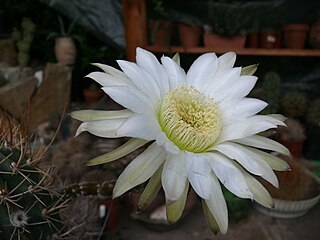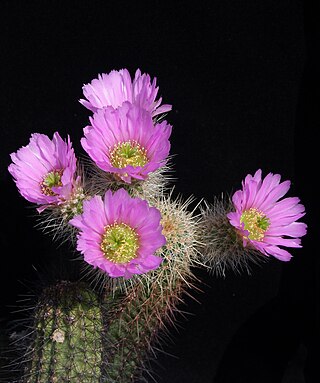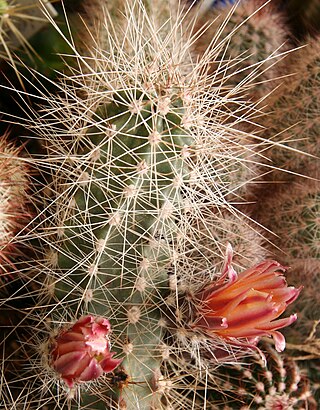
Stetsonia coryne, the toothpick cactus, is the sole species in the cactus genus Stetsonia. Stetsonia coryne is native to arid regions of South America, where it grows to a height of 15 to 25 ft tall. It contains mescaline and other alkaloids.

Echinocereus reichenbachii is a perennial plant and shrub in the cactus family. The species is native to the Chihuahuan Desert and parts of northern Mexico and the southern United States, where they grow at elevations up to 1,500 meters (4,900 ft). This cactus earned the Royal Horticultural Society's Award of Garden Merit.

Echinocereus subinermis is a species of flowering plant in the cactus family Cactaceae, native to north, northwestern, and central Mexico.

Cochemiea goodridgei is a species of plant in the family Cactaceae. It is endemic to Mexican state Baja California.

Lobivia pentlandii, is a species of Lobivia found in Bolivia and Peru.

Echinopsis strigosa, is a species of Soehrensia in the cactus family. It is native to north western Argentina. It was first published in Cactaceae Syst. Init. 28: 31 in 2012.

Matucana haynii is a species of Matucana found in Peru.

Acanthocalycium leucanthum is a species of flowering plant in the cactus family Cactaceae from Argentina.

Echinocereus cinerascens is a species of cactus native from Texas to Mexico.

Echinocereus salm-dyckianus is a species of plant found in Mexico.

Echinocereus spinigemmatus is a species of cactus native to Mexico.

Echinocereus acifer is a species of Echinocereus found in Mexico

Echinocereus viereckii is a species of cactus native to Mexico.

Echinocereus mapimiensis is a species of cactus native to Mexico.

Echinocereus ledingii is a species of cactus native to Arizona.

Echinocereus ortegae is a species of cactus native to Mexico.

Echinocereus adustus is a species of cactus native to Mexico.

Echinocereus pamanesii is a species of cactus native to Mexico.

Echinocereus pulchellus is a species of cactus native to Mexico.

Echinocereus schereri is a species of cactus native to Mexico.
























